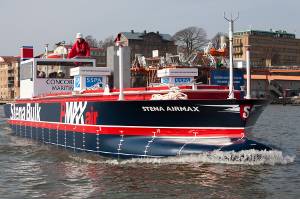
The 49.2 ft long ship prototype Stena Airmax was named in Gothenburg. The prototype is part of a project in which an air cushion is being tested to investigate to what extent it reduces the friction between the hull and the water, thus also reducing fuel consumption and emissions of large tankers in the future. Stena will invest in the region of $6.8m in the project. Following the very good results achieved in tests with small ship models, Stena Teknik has developed this large-scale model weighing 25 tons. The same tests will now be carried out with the Stena Airmax. Anneli Hulthén, Chairperson of the Gothenburg City Executive Board, will be the godmother at the naming ceremony.
Five years ago, Stena Teknik initiated a development project in order to find a method of reducing a ship’s water resistance, thus radically reducing energy utilization and fuel consumption.
“The results of the tests carried out are very promising. Depending on the type of ship and speed, we expect energy savings of 20-30 percent. This will now be verified in tests with the newly built prototype Stena Airmax”, said Ulf G. Ryder, President and CEO of Stena Bulk.
Stena Teknik has co-operated with Chalmers University of Technology and SSPA in Gothenburg in the development project and the construction of the P-MAXair model. The Stena Airmax will be tested in the Gullmars Fjord on the Swedish West Coast, during spring 2010 when extensive - test programs will be run. The model will be powered by electric motors during these simulations.
The concept involves reducing the wet surface,, i.e. the part of the hull that is in contact with the water, thus slowing down the ship. This is achieved by means of a cavity filled with air in the bottom of the hull. This means that the water is in contact with air instead of steel plate, thus reducing friction. This may seem simple, but a number of phenomena complicate the picture. These include internal wave formation in the cavity, which reduces the positive effect. A balance must also be struck between optimizing the air pressure to achieve the greatest possible reduction in resistance and, at the same time, minimizing air leakage.
Testing ship models in test basins has a long history and the technique of scaling up the results from a model to an actual ship is well known. However, Stena’s project is different in that air is also involved. There is no previous experience of the effect of the air when a model is scaled up to full scale. Building a ship based on normal model tests of a 4 m long model would have been very risky.
Accordingly, Stena decided to build a 1:12 model, i.e. a 49.2 ft long model, to verify that the results achieved also applied on a larger scale. This has never been done before. Testing the air regulation system will also be an important part of a future project. Stena has applied for a patent for the wide and flat bulbous bow, which facilitates a favourable water flow below the hull.
Technical data for the Demonstrator model Stena AirMax on a 1:12 scale
Length 49.2 ft
Breadth 10.8 ft
Draft, fully loaded 3 ft
Weight, fully loaded 35 tons
Speed 5 knots
Propulsion 2 x 10 kW
Full scale:
Length 597. ft
Breadth 131.2 ft
Draft, fully loaded 37 ft
Weight, fully loaded 65,000 tons
Speed 14 knots
Propulsion 2 x 8,000 kW
The model consists of a steel box, containing all the equipment, surrounded by a hull made of fibreglass reinforced plastic. The flat bottom has a cavity for an air cushion, which is almost as wide and half as long as the ship. The model is powered by two electric engines with electricity provided by a diesel generator.
The air cavity is fed with air by fans and the air is controlled so that the bottom of the air cushion is in line with the bottom of the hull. The model will be manned by one to two persons. Test data is transmitted via a link to a tender boat. Personnel and boats from the Swedish Sea Rescue Society will assist during the tests.


